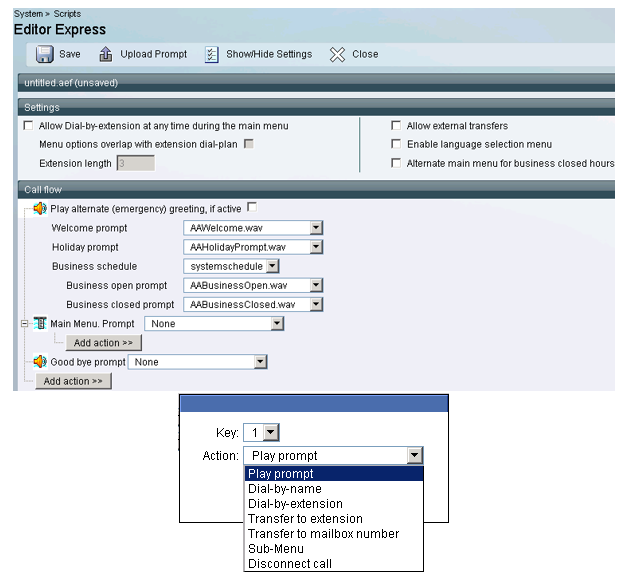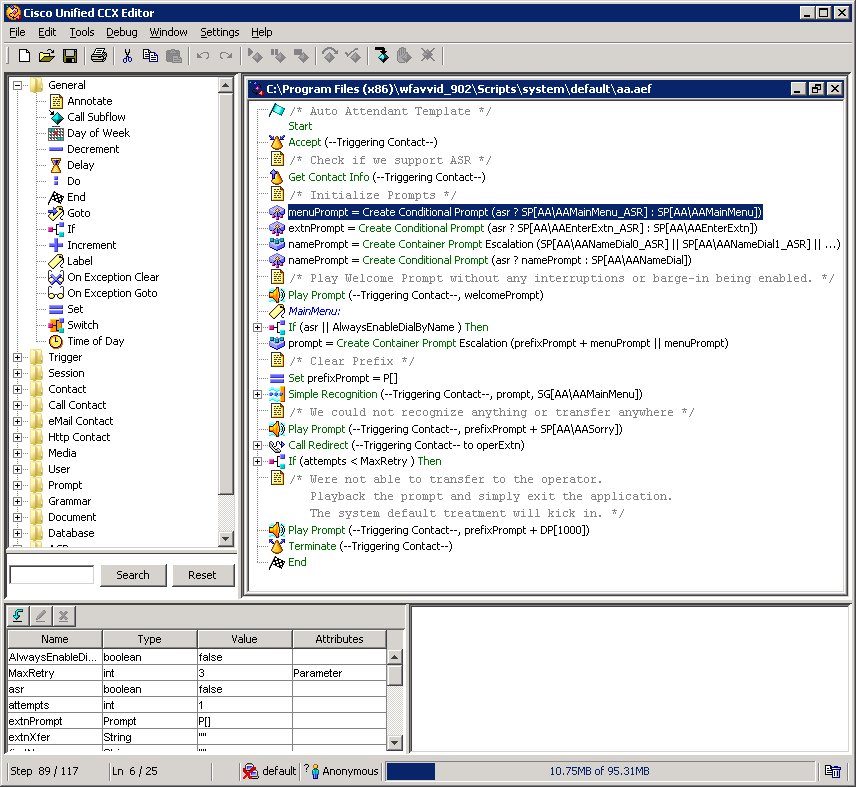Implementing an auto attendant based on Cisco solutions

When calling almost any company, we usually hear a pleasant or not so much voice, reminding us where we got through and offering to perform some actions. We got ... hit the auto attendant. Auto Attendant (Eng. Auto Attendant / AA) is usually the simplest case of the Interactive Voice Menu (Eng. Interactive Voice Response / IVR) , which allows you to dial an extension number, send a voice message or fax, or contact a secretary when calling the company.
In this article, I propose to become familiar with the options for implementing an auto attendant based on Cisco solutions. There are at least four of them and when implementing solutions of unified communications of Cisco, we are often asked the question of what exactly to implement this functionality. Let's look at the pros and cons of each.
')
1. Development or use of ready-made scripts on TCL and VXML
This solution is fully software, the functionality is built into the Cisco IOS operating system, and is supported on routers with the Unified Communications feature set (UC) activated. There are a lot of examples of IVR scripts for Cisco equipment. For example, on Habré you can find options for TCL and VXML .
The advantages of this option include:
- No additional hardware required, except for the Cisco router itself with UC functionality.
- A wide range of supported platforms: 1861, 2800, 3800, 2900, 3900, 4000, AS5000.
- Since you are programming, you can implement any desired script operation algorithm — branching, submenus, several language versions, working / non-working time, etc. Integration with speech recognition and speech synthesis systems (ASR, TTS) and much more is supported.
- A larger set of supported codecs for greetings when using VXML than in all other options. It also supports what no one, as a rule, does not use - a combination of greetings recorded using different voice codecs within the same application.
- Direct access to the gateway and its resources - for example, during a call you can catch a fax tone and immediately switch to a fax, and during outgoing calls, you can understand (with some probability, of course) who answered the call: a person or an answering machine.
- VXML is an open standard supported by many VoIP solution developers (Audiocodes, Huawei, D-Link, Digium).
- There is a ready-made, fairly functional script from Cisco, written on the basis of the TCL - Basic automatic call distribution (B-ACD) and auto-attendant (AA) service.

If you like the algorithm of his work - we take, set up and use.
The disadvantages of this option include:
- In the case of TCL, programming skills and knowledge of the Cisco Voice Gateway API (VGAPI) are required. In the case of VXML, the threshold for entering the topic of programming is much lower, especially for those who are already familiar with XML, knowledge of Cisco VGAPI is not required.
- Cisco IOS does not use a transcoder for calls being processed by applications on TCL, so you must use the same voice codec at both the input and the output of the application.
- Relatively weak scalability - from 7 (2800 series) to 360 (AS5400XM) simultaneous sessions (calls).
- There is no fault tolerance.
- The functionality of the Cisco IOS Voice XML Browser is licensed by the number of simultaneous calls (price * for 1 session FL-VXML-1 = $ 150, for 12 sessions FL-VXML-12 = $ 1,440). FL-VXML licenses are of type Right to Use, i.e. Upon purchase, you will receive a certificate of use, without any serial numbers or product activation codes (“honor based”).
This option is suitable for a small load on the number of simultaneous calls and can be integrated with any PBX (not only Cisco).
2. Using Cisco Unity Express (CUE)
This solution is presented as a module (for example, SM-SRE-700-K9) in Cisco 1861, 2800, 2900, 3800, 3900 series routers. The IVR script is created using the Cisco Unified Communications Express Editor. The solution is functional enough, and the process of creating a script and the logic of the work strongly overlap with the older solution based on UCCX, which we will discuss below. Cisco Unity Express integrates with Cisco Unified Communications Manager and Cisco Unified Communications Manager Express, as an auto attendant can work in standalone mode.
The advantages of this option include:
- Convenient WEB management interface for Cisco Unity Express - Administration.
- Rich in features functional.
- Convenient work with the schedule, weekends and holidays.

- The development of an IVR script in the Cisco Unified Communications Express Editor is quite simple and resembles rather a visual programming with dragging the necessary blocks and setting their properties.

- There is also a simpler one - the web editor editor express for scripts with support for basic actions:

- There are built-in system phrases in different languages, as well as a ready script auto attendant (aa.aef).
- Cisco Unity Express is a voice mail server, so with the introduction of CUE, in addition to the auto attendant, we get voice mail functionality on the router.
The disadvantages of this option include:
- Weak scalability. Hard limit on the maximum number of sessions (10 for ISM-SRE-300-K9 and 32 for SM-SRE-700 - SM-SRE-910).
- For greetings, only G.711 u-law codec is supported.
- There is no fault tolerance.
- Requires installation, configuration, integration.
- The cost of the module and licenses for voice ports (the number of simultaneous calls):
- The module itself: for example, ISM-SRE-300-K9 = $ 1000, includes a non-portable license for 2 voice ports FL-CUE-NR-PORT-2.
- License for mailboxes 5pcs FL-CUE-MBX-5 = $ 100.
- License for additional voice ports 2 pcs. - FL-CUE-PORT-2 = $ 500.
- License for IVR voice ports FL-CUE-IVR-2 = $ 1400 (only needed when using advanced IVR functions like sending email, faxes, accessing external databases, running VXML scripts inside CUE IVR scripts, etc. .).
This option is most suitable for companies using Cisco Unified Communications Manager Express as a PBX or for branch offices where a Cisco Unified Communications Manager PBX is deployed in the central office, and the fault tolerance of the branches is provided by Cisco Unified Survivable Remote Site Telephony (SRST). This option as well as in the case of TCL / VXML can be integrated as a standalone auto attendant with any PBX.
3. Using Cisco Unity Connection (CUC)
This solution is a voice mail server and is installed on a separate virtual machine. Two CUC virtual machines merge into a failover cluster. Built-in CUC tools allow you to create an auto attendant logic. Used built-in call handlers - handlers.
The advantages of this option include:
- High scalability and fault tolerance - up to 250 simultaneous sessions (calls) on a single server, up to 500 in an active / active cluster.
- A fairly wide range of supported codecs (G.711 a / u-law, G.722, G.729, iLBC), as well as embedded transcoding capabilities. It is worth noting that transcoding in CUC always happens.
- Convenient work with the schedule, weekends and holidays.
- Built-in ASR and TTS with Russian support.
- Cisco Unity Connection is a voice mail server. In addition, with the introduction of CUC, in addition to the auto attendant, we get voice mail functionality in the IP telephony system.
- Ability to integrate with third-party (non-Cisco) PBX.
The disadvantages of this option include:
- Weak functionality. Since the built-in standard constructions (handlers) are used to create an auto attendant, the functionality that can be implemented is limited.
- Built-in phrases (for example, the called party is busy) cannot be replaced with your own.
- Requires installation, configuration, integration.
- License cost for 1 voice mail user (mailbox) UNITYCN11-STD-USR $ 78.75
This solution is suitable for companies that require a high load by the number of simultaneous calls and resiliency is important.
4. Based on contact center (Cisco Unified Contact Center Express or Cisco Unified Contact Center Enterprise)
The most functional and flexible solution. UCCX, as well as CUC, is installed on a separate virtual machine. Two virtual machines can be combined into a failover cluster. For an auto attendant, setting the IP IVR functionality is sufficient. We create an IVR script using the Cisco Unified CCX Editor. UCCX integrates with Cisco Unified Communications Manager. The maximum number of sessions is limited by the capacity of the virtual server (virtual machine template) and the number of licenses purchased.
The advantages of this option include:
- High scalability and fault tolerance.
- Support for the most commonly used G.711 a / u-law codecs, G.729.
- The richest in functionality.
- Web management interface - Cisco Unified CCX Administration.
- Developing an IVR script in the Cisco Unified CCX Editor is relatively simple and resembles visual programming.

- There are built-in system phrases in different languages, as well as a ready script auto attendant (aa.aef).
The disadvantages of this option include:
- Requires installation, configuration, integration.
- Solution cost: Minimum promotional package for 5 agents (operators) of the contact center and 100 voice ports (simultaneous calls): $ 1044.75
UCCX is a full-fledged contact center with support for advanced contact center technology, so using it only to create an auto attendant is to shoot a cannon at sparrows. This solution is suitable for companies with high demands on functionality, performance and reliability.
We considered various options for organizing an auto attendant. The choice depends largely on what solution is available or being implemented (CUCMe, CUCM, BE6K or third-party PBX), as well as what requirements for functionality, performance and reliability are presented.
Conclusion
The simplest option would be a TCL / VXML based IVR, and the most functional and productive one would be based on Cisco Unified Contact Center Express / Enterprise.
The Cisco Unity Connection solution is not always deserved and often overlooked. Typically, when purchasing Cisco Unified Communications products, Cisco Unity Connection comes bundled with purchased licenses (for example, when purchasing UWL licenses, as well as bundled Business Editions). In this case, you don’t need to purchase anything to implement the auto attendant.
The Cisco Unity Express solution removes the load (compared to the TCL / VXML use case) for handling calls from the router, occupies an intermediate position between the scripting solutions on IOS and solutions on dedicated servers. It is quite simple and convenient, therefore it is suitable for solving the task of organizing an auto attendant using the own IT department of the company, since has a simple built-in web editor for scripts with support for basic actions.
There are options for integrating Cisco IP telephony systems with third-party solutions to implement the auto attendant function, but that's another story ...
Source: https://habr.com/ru/post/301696/
All Articles